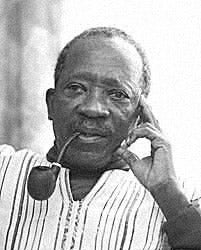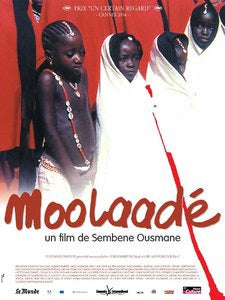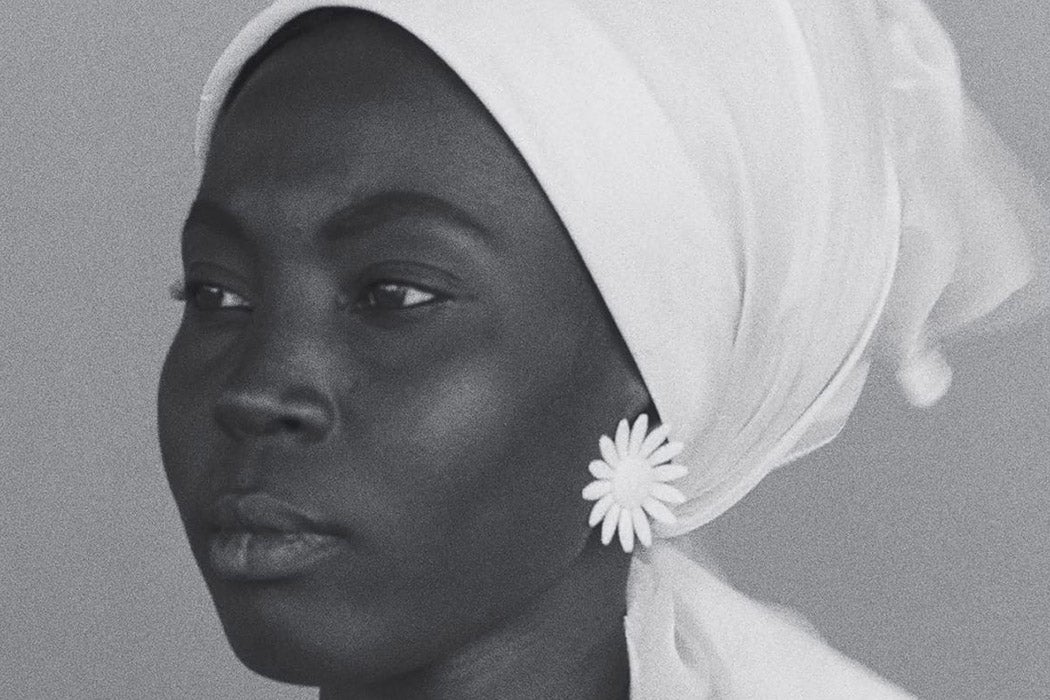When approaching the topics of gender equality and feminism in Africa, many artists and writers come to mind as early advocates for women through their artistic and literary engagement. However, one of the loudest and most resounding of these voices was that of filmmaker Ousmane Sembène (1923–2007), who has been described as “the grandfather of African cinema.”
As women’s history month draws to a close, we invite you to explore some of the scholarship about Sembène, whose work challenges Western notions of gender and sexuality. The non-exhaustive bibliography below explores some of his most powerful female characters and their stories of resistance and resilience. Sembène’s female protagonists take the lead in films where race, gender, and class intersect in complex ways, reminding us how different forms of discrimination imposed on women interact with and compound each other over time. For Sembène, categories of gender and sexuality are not fixed or universal, but are social constructions shaped by historical context and cultural values. Annotations below appear in chronological order by publication date.

Mortimer, Robert A. “Ousmane Sembene and the Cinema of Decolonization.” African Arts 5, no. 3 (1972): 26–84.
Robert Mortimer’s 1972 article captures Sembène’s ideas about “the relevance of the film as a vehicle of education and liberation in contemporary Africa.” Suggesting that Senegal’s cinema was following a path of development “not unlike that of Senegalese literature three decades earlier,” Mortimer documents Sembène’s shift from novelist to filmmaker as part of “a profound commitment to a socially relevant art.” Sembène felt he was caught in “a web of contradictions”: though he was dedicated to a cinema of liberation and decolonization, financially, he was bound to French resources (two French companies in particular). What good could a film that fills only French coffers do for an African nation? Sembène and Mortimer both have ideas about the steps that needed to be taken to create national support and thus “liberation from foreign control.”
Sembène, Ousmane. “‘Film-Makers Have a Great Responsibility to Our People’: An Interview with Ousmane Sembene.” Cinéaste, vol. 6, no. 1 (1973): 26–31.
This interview was conducted in 1972 by Harold D. Waver, Jr., former Chairman of the Department of Africana Studies at Rutgers University, and translated by Sembène’s American interpreter, Carrie Moore. This conversation took place in Philadelphia on the occasion of Sembène’s participation in the 15th annual Meeting of the African Studies Association. Sembène reveals his aims and responsibilities as a filmmaker, with a particular emphasis on his then recent film Emitaï (1971), which portrays a standoff between French soldiers and a group of village women. This film examines the resistance of the Diola people to French rule in Senegal during World War II, and it makes an important critique on what has always been the significant, yet overlooked role of women in African communities. When the French occupation force demands rice to help the war effort, the Diola people, and particularly women, refuse to comply because of the ethnological importance of the rice for them. Some of the major points that Sembène raises in this exchange include overcoming colonialism and learning from previous stories of marginality. He also highlights the importance of women in the act of resistance to colonialism.
Weekly Newsletter
Iyam, David Uru. “The Silent Revolutionaries: Ousmane Sembene’s Emitai, Xala, and Ceddo.” African Studies Review, vol. 29, no. 4 (1986): 79–87.
In this article from 1986, David Uru Iyam, an associate professor of Anthropology at Whittier College, analyzes the power of female characters, whom he describes as silent revolutionaries and emblems of African female strength and resilience. According to Iyam, Sembène views his role as an artist as someone who has the responsibility to denounce what he sees wrong in society without making prescriptions, all while provoking and disturbing the mind. Iyam discusses the film Ceddo (1977), in which Sembène shows how foreign religions set out to change the identity of the people by making them question their established beliefs and disturbing their cultural traditions. In Ceddo, audiences witness a protest of forced conversion to Islam, leading the “ceddo,” or outsiders, to kidnap King Demba War’s daughter, Princess Dior Yacine, and hold her hostage. In this film, audiences meet the conspicuous yet silent character of Princess Dior, who is used by Sembène to highlight a woman as the major and final element of confrontation in the conflict in a culture where little regard is given to the female gender, a twist that further intensifies the evolution and eventual resolution of the plot.
Iyam also analyzes female characters in Xala (1975), a film based on Sembène’s novel of the same name. In this story, El Hadji is a prominent man in his community who cheated his way to success and wealth. He decides to take on a third wife, but he becomes sexually impotent and thus affected by the curse of “xala.” El Hadji suspects that one or both of his first two wives have put the “xala” spell on him, without realizing that the true spell comes from his own behavior and disregard of the people he has wronged, particularly the beggars, namely Gogul. Throughout both film and novel, El Hadji seeks to remove the spell, which eventually leads his business to crumble. While Sembène uses sexual impotence as the motor of the story, it’s truly the impotence of class structures and hierarchies that are at play. Through a satirical account of El Hadji’s physical and sexual impotence, the readers and audiences witness the impotence of the bourgeoisie that inflicts neocolonial crippling measures on the post-colonial nation. At the end, El Hadji has to return to his senior wife’s home to be purified of “xala,” making it crystal clear that the role of the woman in the African nation is one of education and healing, as the woman, after all, is the one who holds the key to his healing and purity.
Pallister, Janis L. “From ‘La Noire de. . .’ to ‘Milk and Honey’: Portraits of the Alienated African Woman.” Modern Language Studies 22, no. 4 (1992): 76–87.
Janis Pallister, former Bowling Green State University Distinguished University Professor of Romance Languages, suggests that the traumatic events and horrific conditions Sembène’s female protagonists suffer in La Noire de… or Black Girl (1966) are specific to Black women. That is, while “some of the traumatic events and conditions portrayed might have been undergone by a male or by a white woman,” the totality could only be experienced by a Black woman. (See the Vlad Dima annotation below for a short summary of the film.) Although some critics imply that the social gap between the main character, Diouana, and her French employers, is more economic than racial, Pallister writes that such an argument “is specious, as obviously the two elements are fused and as obviously Ousmane Sembène focuses our attention on the protagonist’s color.” And Diouana’s “extreme alienation” also had a linguistic dimension. Pallister reminds us that she is “for the most part speechless, speaks very halting French.” Pallister credits Sembène for his ability to show so clearly an experience he could not have had himself. “But that should not be a surprise, really,” she muses, “as he is known to be an advocate of women and to have taken the woman’s point of view in other works.”
Rapfogel, Jared, Richard Porton, and Ousmane Sembene. “The Power of Female Solidarity: An Interview with Ousmane Sembene.” Cinéaste 30, no. 1 (2004): 20–25.
This interview with Sembène took place in 2004 on the eve of the American premiere of his film Moolaadé at the New York Film Festival. Samba Gadjigo, a professor at Mount Holyoke College, provided the simultaneous translation. In this interview, female excision, the main topic of Moolaadé, is discussed. In the film, six village girls refuse to undergo the ritual circumcision and thus cause a revolution and uproar in their village. In what most Western audiences would expect to be an exotic African spectacle, audiences are confronted with a deeply moving story that addresses the emancipation of women and the persisting divisions and tensions between generations where tradition, the old, and spiritual worlds clash with the new, secular, and medically informed decisions. The film’s last scene is particularly poignant since a majority of the village women join Collé, a mystical woman who has the power of “moolaadé,” the ancient spell of protection.
 This film is particularly important in Sembène’s body of work as it is directed towards an audience of Africans of all nations, addressing once and for all the issues at hand with this practice that particularly impacts women. The film expresses a relative optimism, with a conviction that change is possible and that the suffering of young girls and women is in vain. Moolaadé was filmed in a village in Burkina Faso, with the idea that it would suggest similar locales throughout the continent. Sembène aspired for Moolaadé to cross national and cultural boundaries, for it would be, according to him, a catalyst for discussion of this destructive and painful tradition.
This film is particularly important in Sembène’s body of work as it is directed towards an audience of Africans of all nations, addressing once and for all the issues at hand with this practice that particularly impacts women. The film expresses a relative optimism, with a conviction that change is possible and that the suffering of young girls and women is in vain. Moolaadé was filmed in a village in Burkina Faso, with the idea that it would suggest similar locales throughout the continent. Sembène aspired for Moolaadé to cross national and cultural boundaries, for it would be, according to him, a catalyst for discussion of this destructive and painful tradition.
 In this interview, we hear from Sembène directly as he discusses the effects that Moolaadé has had on African audiences, especially given its daring and multifaceted approach to interweaving tradition and modernity in contemporary African culture. He shares with his interviewer that the movie has led many men to convert to becoming against this painful tradition, but that usually it’s women who are more readily accepting of change against the violent repercussions that excision has on women. He also denounces the claims that his film is violent because he believes that his depiction of the tradition is not even close to the true and accurate devastation wrought by excision. He also discusses his other then-recent film, Faat Kiné (2000), which depicts a Senegalese single woman and mother of two who discovers the power of money and the value of freedom.
In this interview, we hear from Sembène directly as he discusses the effects that Moolaadé has had on African audiences, especially given its daring and multifaceted approach to interweaving tradition and modernity in contemporary African culture. He shares with his interviewer that the movie has led many men to convert to becoming against this painful tradition, but that usually it’s women who are more readily accepting of change against the violent repercussions that excision has on women. He also denounces the claims that his film is violent because he believes that his depiction of the tradition is not even close to the true and accurate devastation wrought by excision. He also discusses his other then-recent film, Faat Kiné (2000), which depicts a Senegalese single woman and mother of two who discovers the power of money and the value of freedom.
Adesokan, Akin. “The Significance of Ousmane Sembène.” World Literature Today 82, no. 1 (2008): 37–39.
Akin Adesokan wrote this piece following the death of Sembène in 2007 to pay homage to the significant impact the filmmaker had on African cinema and the world of cinema as a whole. In this eulogizing piece, Adesokan gives an overview of the progressive and radical work that Sembène was able to achieve throughout his career. From his first film Borrom Sarret (1963)—also known as the first film made in Africa by an African, the first “professional” African film, and the first such film to be shown widely outside of Africa—to his last film Mooladé (2004), Sembène established himself not only as one of the pioneers of African cinema but also as one of the best and most impactful political filmmakers. His life followed a circuitous journey. He was initially trained as a dockworker but was drafted into the French army during World War II, which then led him to become a trade-union activist in Marseille, where he began his career as a novelist, his first books including Le docker noir and God’s Bits of Woods, before taking on film, with Borrom Sarret (1963) and La Noir de… (1966).
Janis, Michael. “Remembering Sembène: The Grandfather of African Feminism.” CLA Journal 51, no. 3 (2008): 248–64.
Michael Janis discusses the feminism/womanism of the late writer and director Ousmane Sembène, introducing readers to the genius that was Sembène and to the powerful socialist criticism of colonialism that his novelist-filmmaking produced, offering a new vision for contemporary African societies. Not only was Sembène devoted to showcasing and celebrating the resilience and power of African women, but his work provides a powerful critique of patriarchal systems. Janis rightfully points to the fact that while “grandfather of African feminism” may resonate with undertones of problematic traits of what may be termed “patriarchal feminism,” this critique is not only dangerous but does great disservice to the mission of Sembène and his contemporaries to advance the cause of women’s liberation and gender equality. Janis shows how beautifully and skillfully Sembène presents the fascinating, multifaceted, and complex female characters who, despite sometimes being relegated to the very margins of society, end up as the protagonists and heroines of the narrative, leaving the readers and audiences with the final say and making the most impact.
Dima, Vlad. “Ousmane Sembene’s ‘La Noire de…’: Melancholia in Photo, Text, and Film.” Journal of African Cultural Studies, vol. 26, no. 1 (2014): 56–68.
Vlad Dima discusses Sembène’s La Noire de… (1966), a film featuring the female character with probably the most harrowing and tragic story of all Sembène’s characters, given that the violent ending to her journey results in her death. La Noire de… was originally a short story form in Sembène’s collection Voltaique (1962); three years later Sembène transformed the story for the screen, and it became the first African film to gain critical recognition in the West. The story centers on Diouana, a young Senegalese woman who takes a job as an au pair for a French family and moves to France. However, following mistreatment by the family and their circle, she becomes disillusioned with a bright and happy future in the promised land, France. Initially under the impression that she would work as an au pair, she actually ends up being an imprisoned maid who is treated no different than a slave. She falls into despair and ends up taking her own life as her dreams and aspirations fail to match the reality of the situation and that of the imagined promised land. Dima analyzes the various shapes of melancholia across photo, text, and film to offer an analysis of what they mean within the larger social context of Senegal and West Africa.
Harrow, Kenneth W., ed. African Filmmaking: Five Formations. Michigan State University Press, 2017.
Kenneth Harrow’s edited volume on African filmmaking is a great place to start your reading if you’re new to the subject. Harrow, Emeritus Distinguished Professor of English at the University of Michigan, has written extensively on Islam and African literature, African cinema, and women in African literature and cinema. Here, he considers a range of African film traditions, addressing “the historical background of African cinemas in South Africa; North Africa, including Egypt and the Maghreb; and the Anglophone countries of Ghana and Nigeria, as well as Francophone cinema.” Each of the five chapters offers an in-depth analysis of a regional film tradition. Particularly useful for contextualizing Sembène’s work is African Francophone Cinema, a chapter co-authored by Harrow and Olivier Bartlet, a French journalist, translator, film critic and researcher on African cinema and its diasporas.







